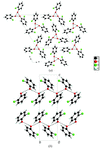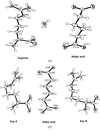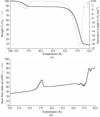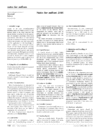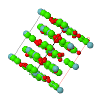issue contents
February 2005 issue

Cover illustration: The arrangements of boxes shown represent the possible packing patterns of four molecules (each with dimensions L, M and S) in a unit cell, as described by the Box Model of crystal packing [Cryst. Growth Des. (2004), 4, 611-620]. Application of this model to experimental P21/c structures revealed that the lower surface area packing patterns, for example 221L and 221M, are populated to a much greater extent than the higher surface area packing patterns of 114M and 114L. This finding indicates molecular shape is of primary importance in crystal packing [Acta Cryst. B60, 539-546; Acta Cryst. B60, 725-733].
research papers
Download citation


Download citation


The crystal structures of both CaTbF6 and CdTbF6 have been solved from X-ray and/or neutron powder diffraction data, emphasizing the relationship between the crystal chemistry of the Tb4+ ion in fluorides and the half-filled shell of its 4f7 electronic configuration.
Single microcrystals of the new compound SmMn2GeO7 were grown by the flux method in a double spherical mirror furnace. The material has been characterized by electron microscopy.
Download citation


Download citation


The single crystal structure of a β′-copper vanadium bronze, Cu0.63V2O5, has been studied at room temperature and 9.6 K, and compared with the β-sodium vanadium bronze, Na0.33V2O5, structure. The space group C2/m, suggested by the X-ray diffraction measurements, has been confirmed using convergent beam electron diffraction (CBED).
A direct correlation between the metal-environment distortion and the temperatures of occurrence of the thermal and the light-induced spin crossovers is clearly shown in a series of mononuclear iron(II) complexes.
A new method to assess crystal structure dissimilarities is described and applied to classification and clustering problems.
Download citation


Download citation


Global lattice energy minimizations were used to solve the crystal stucture of C22H12Cl2N6O4 from a low-quality X-ray powder diagram, which consisted of 12 visible peaks only.
Download citation


Download citation


Open  access
access
 access
accessThe crystal structures of eight new co-crystals of quinol with simple hydrogen-bond acceptors are reported. All structures are dominated by hydrogen bonding between quinol and the guest molecules. A doubly bridging motif is present in all but two of the co-crystals.
Download citation


Download citation


Open  access
access
 access
accessThe crystal structure of L-serine has been determined at room temperature at pressures from 0.3 to 4.8 GPa. Above 4.8 GPa the structure transforms to a new polymorph, the structure of which has been determined at 5.4 GPa.
Download citation


Download citation


Open  access
access
 access
accessThe crystal structures of 2-fluorophenol, 3-fluorophenol, 3-chlorophenol and 4-chlorophenol have been obtained at low-temperature and at high pressure.
Download citation


Download citation


The crystal structures of forms I and II of phenobarbital were solved at room temperature from X-ray powder patterns. The Monte-Carlo simulated annealing method was used to find a starting structural model. The final structures were obtained by Rietveld refinements with geometric soft restraints on bond lengths and angles.
Download citation


Download citation


Complexes of arginine with comparatively long dicarboxylic acids such as adipic acid, and those with formic and acetic acids tend to exhibit a similar mode of supramolecular association.
Download citation


Download citation


Open  access
access
 access
accessThe molecular conformation and hydrogen-bond patterns of 4-piperidinecarboxylic acid at various temperatures were investigated by means of X-ray powder diffraction, TGA and DSC.
Download citation


Download citation


Open  access
access
 access
accessThe supramolecular structures of three stereochemical forms of 1-phenylethylammonium hydrogen tartrate and three stereochemical forms of bis-1-phenylethylammonium tartrate are analysed in terms of their anion substructures.
Download citation


Download citation


Charge densities based on four data sets for (−)-strychnine measured with different experimental setups at different low temperatures were analysed in terms of topological parameters. Agreement among the four experimental charge densities was found to be better than between experiment and theory.
international union of crystallography
Free 



 journal menu
journal menu



















